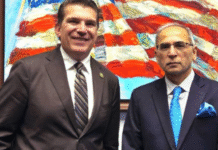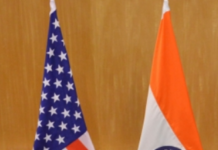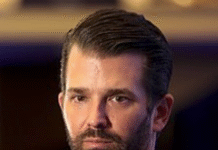HONOLULU — Senior military leaders from India and the United States are holding extensive discussions aimed at strengthening bilateral defense ties, improving interoperability, and reinforcing a free, open, and secure Indo-Pacific during the 22nd India–U.S. Military Cooperation Group (MCG) meeting that began Monday in Hawaii.
The two-day meeting, co-chaired by Chief of Integrated Defence Staff Air Marshal Ashutosh Dixit and Lieutenant General Joshua M. Rudd, Deputy Commander of the U.S. Indo-Pacific Command, marks another step in the expanding defense partnership between the two nations, according to the Integrated Defence Staff headquarters in New Delhi.
“The event witnessed productive discussions with senior military leaders focusing on strengthening bilateral defense engagements, enhancing interoperability, and promoting a free, open, and secure Indo-Pacific region,” the HQ IDS said in a post on X.
The MCG serves as a key institutional forum for advancing defense cooperation between the armed forces of both countries through regular dialogue on strategic and operational matters. The 21st edition of the meeting, held last year in New Delhi, covered issues including capacity building, training exchanges, defense industrial collaboration, and the advancement of joint exercises to prepare for conventional and hybrid threats.
During that meeting, both sides had emphasized the growing importance of the Indo-U.S. defense partnership and reaffirmed their shared commitment to expanding cooperation to address evolving regional security challenges.
The latest discussions come amid deepening military engagement between the two countries, reflected in large-scale joint exercises such as Yudh Abhyas, Malabar, Vajra Prahar, Tiger Triumph, and COPE India. In September, the 21st edition of Exercise Yudh Abhyas — one of the Indian Army’s largest bilateral drills — was held at Fort Wainwright, Alaska, involving 450 Indian troops from the Madras Regiment alongside U.S. soldiers from the 11th Airborne Division’s 1st Infantry Brigade Combat Team, known as the “Arctic Wolves.”
Since its inception in 2002 as a small platoon-level exercise, Yudh Abhyas has expanded dramatically in scope, spanning diverse terrains from India’s high-altitude regions of Auli and Chaubattia to the deserts of Rajasthan and the icy training grounds of Alaska.
“India conducts more military exercises with the U.S. than with any other country,” the Indian Embassy in Washington stated earlier this year. “These exercises are central to building interoperability and mutual trust, reflecting how our two democracies continue to work together for peace, security, and prosperity in the Indo-Pacific region.” (Source: IANS)












